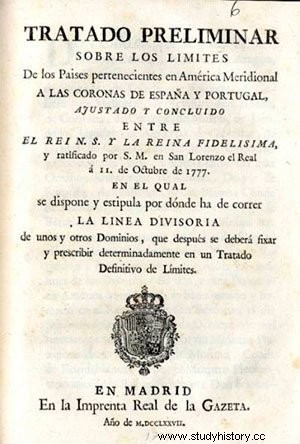Fernando VI died on August 10, 1759, opening the doors to the reign of Carlos III (1759-1788), who arrived in Madrid in December. Considered by most historians as the most active period of the 18th century in the application of the enlightened despotism model, the monarch personally dedicated himself to the exercise of politics surrounded by characters of great value.
Wishing for a continuous policy, Carlos III kept the main secretaries (Wall and Arriaga) in his positions, with changes in the Treasury (Valparaíso was replaced by Leopoldo de Gregorio, Marquis of Esquiladle). Macanaz and Ensenada were released from their prison. The opposition to the reforms undertaken by Carlos III was complicated by a subsistence crisis and the rise in prices in the winter of 1766. The outbreak of the riot in Madrid was due to the edict signed by Esquiladle (March 10, 1766) which ordered to replace the long cape and the wide hat, for a three-cornered hat and a short cape. The desire to ingratiate himself with his subjects led Carlos III to dictate measures that condoned taxes and grain supplies. The riots of 1766 helped implement a physiocratic program stemming from the increased demand for food in a growing population. After Esquiladle left, Aranda was in charge of easing the hectic atmosphere, to which the following year's good harvest also contributed.
Reforms in the Enlightened Despotism of Carlos III
The model of enlightened Caroline despotism addressed a series of actions at the economic, social and religious levels. On the one hand, agrarian reform was promoted and new settlements were founded in the uninhabited areas of the royal lands (Sierra Morena and the middle valley of the Guadalquivir). In addition, numerous public works were created (canals, public hospitals, lighting services, improvements in health and hygiene) and the poor communications system was addressed with the creation of the post system (1763), the establishment of the stagecoach system (1771) and the liberation of trade with America (1778). The army was reorganized with the new ordinances (1768). On the religious level, the moment of rejection of the Society in Europe was used to expel the Jesuits (1768) and undertake an educational reform. And, finally, inventiveness, industry and education were promoted thanks to the spread of the Economic Societies of Friends of the Country since 1775. This model of enlightened despotism was maintained during the decades 1770-1790.
Foreign Policy

Foreign policy was focused on three fronts:France, Portugal and the Mediterranean. By virtue of the third family pact (1761), Spain intervened in the Seven Years' War. By the Peace of Paris (1763), Havana and Manila were returned to Spain by England, while the English managed to expel the French from North America and recovered Menorca. Spain handed over to Portugal the colony of Sacramento, on the Río de la Plata.
Spanish Atlantic policy was aimed at resolving the dispute with Portugal in Brazil (Treaty of San Ildefonso, 1777) and establishing Spanish participation in the War of Independence of the United States (1779).
In the Mediterranean, talks began with the Moroccans. Don Diego María Osorio (Governor of Ceuta) and Sultan Sidi Muhammad Abd Allah reached an agreement to establish a series of consulates (Larache, Tangier and Tetouan). The Peace Treaty with Morocco (1767) tried to iron out rough edges between the two countries in the face of the insistent Moroccan claim on Ceuta and Melilla. The Treaty improved, above all, trade relations, free trade in grains in the area and Spanish fishing in those waters. It would be necessary to wait for the Treaty of Aranjuez (1780) for the Spanish-Moroccan conflict to be temporarily settled.
Significant progress was also being made in the Eastern Mediterranean. In 1782, Spain signed a treaty with the Ottoman Empire, establishing consulates in the main Turkish cities. With the agreement, the Turks were supported against Austria and Russia, allowing future trade agreements to be established with the Far East.
End of the Reign of Carlos III
At the end of the reign of Carlos III, it could be said that Spain, on the one hand, had tried to recover a prestigious international position, sometimes without success, while the reforms in the interior began to give the first results. On the other hand, family misfortunes overwhelmed Carlos III with the death of his three sons (Carlos Eusebio, Carlos and Felipe). The birth of Fernando (October 14, 1784), son of the Prince of Asturias and the future Fernando VII, seemed to ensure the succession. On December 14, 1788, Carlos III died at the age of 72.
